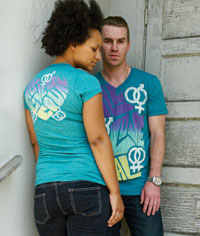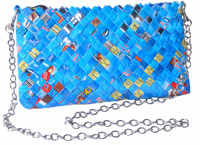Imagine the number of umbrellas that are tossed each year, since one of them might be broken by a strong gust. Most umbrellas are made from nylon, metal and plastic – all materials that come from limited resources such as mined metal ores and oil, and the nylon and plastic could have toxic effects after disposal.
When considering the plastic, for example, imagine the amount tossed on a daily basis. Some is recycled, although plastic bags and bottles do not get made into more of the same, they are usually “downcycled” into lower quality products such as road markers or plastic lumber. When these reach the end of their useful life, these would then probably not be recycled. There is no reason for the cycle to (constantly) end in the landfill. We have enough of them, and landfills are not healthy places.
In nature, waste does not exist. All that dies, simply changes form, becomes food for more life. Could such a change of form and lack of waste happen in human society? In the book Cradle to Cradle: Remaking the Way We Make Things, authors McDonough and Braungart use the term “upcycle” and refer to technical and biological nutrients. They state that all nutrients, whether biological or manufactured, should be part of a closed loop system. Technical nutrients, things like circuit boards, steel parts, wiring and equipment cases, could be returned to the industrial loop from whence they came.
If more materials could be like glass and aluminum in that they are remade again and again into products of equal or even greater value, fewer resources would be extracted and hence fewer ecosystems damaged. Less water and energy would be used in production, and fewer toxins would be produced too. Sounds great, doesn’t it?
We are at least flirting with going in this direction, as some resources are becoming less available and more expensive. More businesses and consumers are interested in upcycling and true REcycling. One can now find products made from other things that were discarded, such as doormats made from recycled flip-flops or plastic bags being woven into strong tote bags. Patagonia, a pioneer in this field, uses some fabrics for their clothing made of 100% recycled materials, including plastic bottles and used clothing. Another pioneer is the carpet company Interface, whose product can be continuously recycled into new carpet. They both offer take back programs to reuse their materials as feedstock for new ones. A company called Terracycle works with manufacturers and consumers to collect packaging that is then made into other goods. They are working with Scotch to recover plastic tape dispensers and cores that will be used again. They make flower pots out of crushed computer housings. Now there’s a nice metaphor for life….
Common Threads Recycling Program
Patagonia accepts old Patagonia clothing for recycling at any of their retail stores. If you’re not near a physical location, you can also send them in to: Patagonia Service Center, ATTN: Common Threads Recycling Program, 8550 White Fir Street, Reno, NV 89523-8939.
Revenge Is…
Going green. The LA-based company Revenge Is produces shirts (with progressive messages) made from a combination of recycled plastic bottles and organically grown cotton. It’s truly upcycling and a fashion statement as well. All Love is Equal supports the organization Love Honor Cherish and marriage equality. Check out their full line at: revengeis.com.
Rebagz
RebagzTM creator Marty Stevens-Heebner believes in recycling, so much so that she designed a line of bags from clutches, wallets and eyeglass cases to messenger bags and more made out of rice bags, juice containers and more. Made under fair labor conditions, many of the designs (from the Statement Markers line) support organizations such as Greenpeace and the Breast Cancer Emergency Fund. To see their full line of the ultra-chic, visit: rebagz.com.
References:
Plasticsrecycling.org


